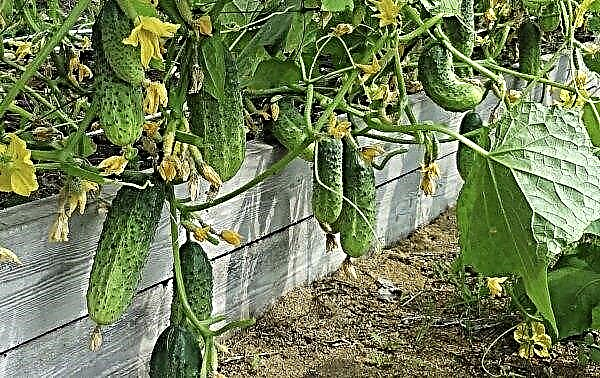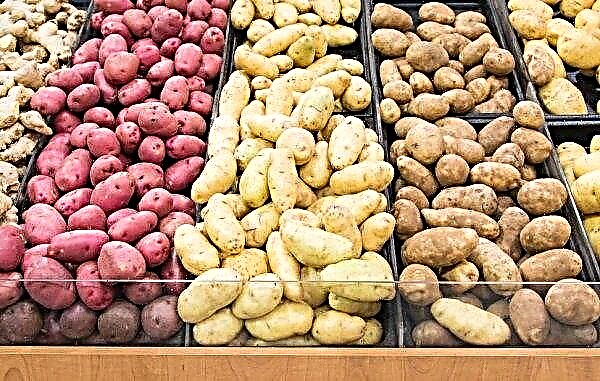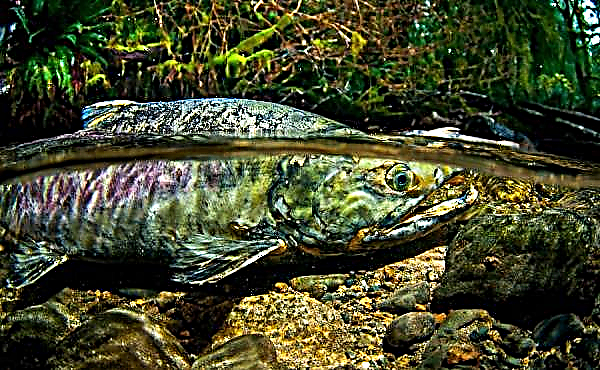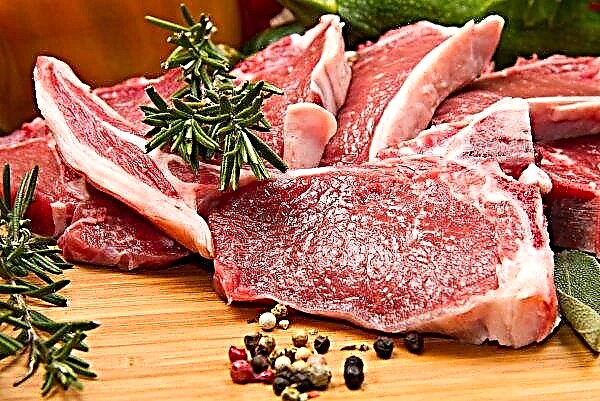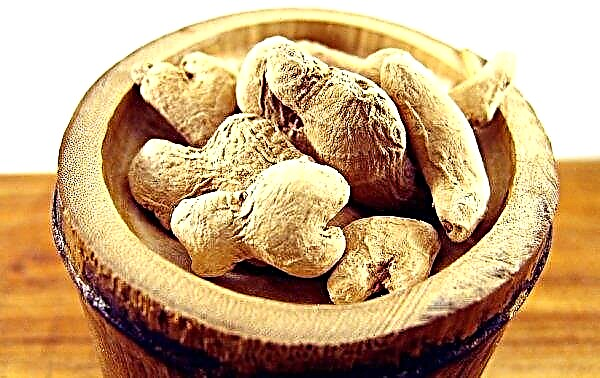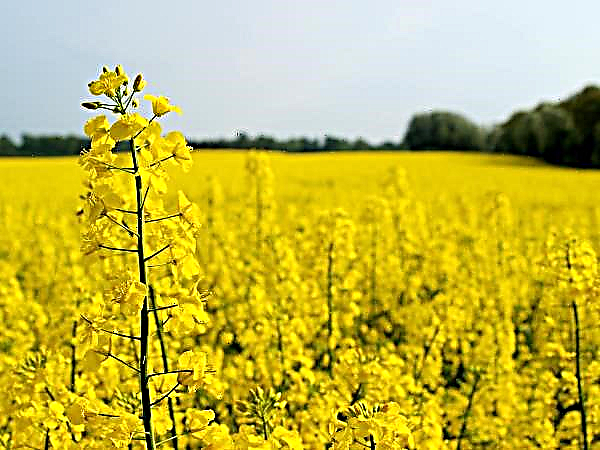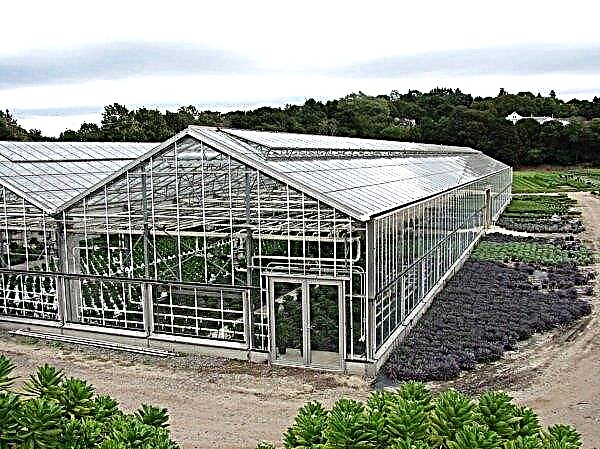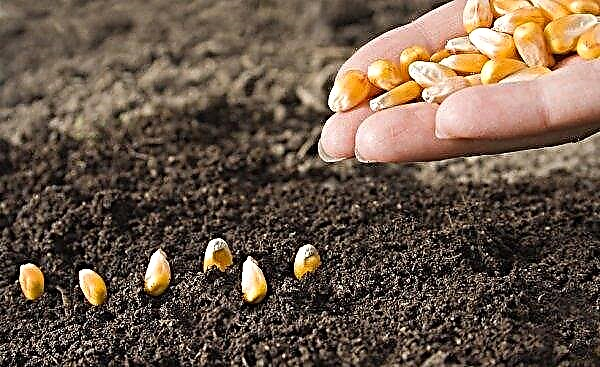Juniper Old Gold or Juniperus chinensis Old Gold can rightfully be attributed to the most beautiful, aesthetically attractive decorative coniferous perennials, which have won wide demand in the field of design landscapes in gardens, parks, and personal plots. What are the main advantages of the described plant, and how to properly care for it in open ground - find out from the article.
Botanical Description
Juniper Old Gold is a perennial evergreen coniferous hybrid bred by Dutch breeders in 1958 by crossing Chinese and Cossack junipers. A feature of the plant is that in width it grows more than in height. Long-growing perennial per year gives an increase in height of 5-7 cm, in width - up to 20 cm. By the age of 10 years it grows to 50 cm, while in diameter it is more than 1 m. In the future, the development of the bush occurs only in width, the largest parameter of which is able to equal about 3 m.

Old Gold has a symmetrical, regular shape flat crown, consisting of dense small shoots located in the horizontal direction relative to the trunk. Particularly attractive is the needles of the plant. It has a very beautiful golden yellow color, which in the winter becomes noble bronze. The needles of the culture are sharp, trihedral, densely located on the shoots and trunk.
The fruits of juniper are conditionally edible cone berries with a round shape and green color.. In the process of ripening, the fruits become blue-black and are covered with a dense wax coating.
Did you know? Juniper ordinary in the people is better known as heather. As a medicine, it began to be used in ancient Egypt and Rome in the II-I millennium BC.
Variety Characteristics
The full name of the described culture is Juniperus Pfitzeriana Old Gold (Juniperus Media x Pfitzeriana Old Gold).

It has the following characteristics:
- Crown. Rounded, flat, symmetrical, with fairly sprawling branches located horizontally.
- Dimensions. The variety grows in width, the circumference of an adult tree is 1.5–2 m, height - up to 1 m. The maximum annual growth varies between 5–7 cm in length and 15–20 cm in width.
- Roots. The shrub has a deep, weakly branched root system. When growing plants on solid, dense soil, a surface root system is formed.
- Frost resistance. Juniper is characterized by good resistance to frost, can withstand low temperatures up to -34 ° C, suitable for planting in the southern, central regions and in the middle zone of Russia. When cultivated in the north, young seedlings need additional insulation for the winter.
Important! Pfitzerian juniper needles contain a small amount of toxic substances, so its juice should not be allowed to fall on the skin or mucous membranes, since it can cause serious allergic reactions.
Landing
Juniper of the described variety does not impose strict planting requirements. is he perfectly takes root in almost any climatic conditions, can tolerate low temperature air and short-term drought. Nevertheless, in order to get a shrub with high decorative properties, experts advise to pay special attention to the planting process.
Video: Planting and caring for juniper
Site selection and preparation
Old Gold belongs to the category of photophilous plants that develop well in sunny, well-lit areas, reliably protected from drafts and cold winds. When growing shrubs in the shade, it loses its decorative qualities, becomes shapeless and faded. As for the soil, the plant does not have high demands on it. The best option for it will be light, air- and moisture-permeable soils with a weak or neutral level of acidity.
Before landing, in about two weeks, experts advise preparing the site - clear of vegetation and dry branches, dig, make a recess. You can independently prepare the substrate using two parts of peat and one part of sod land, river fine sand.

Seedlings preparation
The key to a healthy, aesthetically attractive plant is a quality "fresh" planting material. Choosing a seedling it is recommended to give preference to a plant with a closed root system, as this will allow the material to root faster and adapt to a new place.
You also need to carefully examine the condition of the seedling. It should be healthy, with bright, saturated, not dry needles, with elastic, without signs of fungi or parasites, shoots and without damage to the root system. The purchase of planting material is best done in special garden markets or nurseries.
 Watered the seedling immediately before planting in the open ground, in order to more conveniently remove the earthen
Watered the seedling immediately before planting in the open ground, in order to more conveniently remove the earthen
Detailed landing instructions
Landing work is allowed to be carried out in any warm period of time, choosing a cloudy day for this.
Important! Juniper does not like high density of plantings, therefore, when planting several copies, you should maintain a distance between them of 0.5–2 m, between rows - 1.5–2 m
The landing technology is traditional and is based on the following algorithm:
- dig a hole 2-3 times the size of the root system;
- pour a layer of drainage at the bottom of the trench using expanded clay or broken brick;
- deepen half to fill with fertile soil and lay a seedling;
- gently spread the root processes, cover the plants with soil in such a way that the neck of the root remains on the surface by 6-8 cm;
- lightly compact the soil near the seedling;
- Sprinkle the trunk circle abundantly, cover from above with a layer of natural mulch from peat or sawdust.

Care Features
It is not difficult to take care of the juniper of the described variety, because its care is no different from other varieties of this culture. Most importantly, experts advise to pay special attention to young seedlings, which in the first months of growth need good hydration, nutrition, protection from diseases and parasites.
Did you know? Juniper oil is particularly successful in folk healing. It cleanses, strengthens the immune system, invigorates, tones and serves as an excellent natural painkiller.
Watering and feeding
In the first year of planting, the shrub requires regular watering, which is carried out, focusing on drying the upper layer of soil to a depth of 4-5 cm. In hot summers, the plant is moistened 2-3 times a week. Under normal climatic conditions, the number of irrigations is reduced to 1-2 in two weeks. The culture responds well to sprinkling, which is carried out at least once every 7 days, always in the evening.

To maintain the high decorative qualities of the shrub, to increase its immunity and resistance to illnesses, it should be nourished with mineral compounds. The first portion of fertilizers is applied in early spring for the second year of juniper growth.using nitroammophoska, based on 1 m² 30-40 g of the drug.
The second time the plant is fed two months before frost. In this case, a solution of 10 l of water, 15 g of superphosphate and 10 g of potassium salt is used.
Mulching and cultivation
An integral agro-technical measure for Old Gold care is loosening the soil.
A similar procedure allows you to:
- enrich the earth with oxygen and nutrients;
- activate the growth and development of the root processes of the plant.
Since the root system of the juniper is superficial, loosening is recommended to be carried out extremely carefully, without going deep into the soil.
 To prevent overdrying of the top layer of the soil, to protect the roots from overheating or frostbite, as well as to slow down the growth of weed plants, mulch the earth using organic materials - peat, sawdust, wood bark or wood chips
To prevent overdrying of the top layer of the soil, to protect the roots from overheating or frostbite, as well as to slow down the growth of weed plants, mulch the earth using organic materials - peat, sawdust, wood bark or wood chips
Trimming and Shaping
The culture of the described variety does not need regular pruning, as it is characterized by low growth rates. Specialists advise to trim old, too thin, broken shoots after winter, diseased shoots as necessary. The procedure must be performed in early spring before the sap flow begins.
Important! When pruning, it is impossible to remove the skeletal shoots of a shrub, otherwise it may die.
Juniper Old Gold responds very well to a haircut. To give it a decorative effect, you need to remove all sticking out, "knocking out" of the general form and spoiling the appearance, branches. Such events are best carried out in the first weeks of summer.

Wintering
One of the advantages of the perennial of the described variety is its high resistance to frost. Adult plants do not need special shelter for the winter, it is enough to mulch them and cover the branches with “breathing” material, for example, agrofibre or burlap.
It is very important in early spring, when the thaw begins, to shake the snow from the shoots so that the snow crust does not break them and does not create stagnation of moisture.
Young seedlings of small stature experts advise to insulate. For this, the trunk circle is covered with a thick layer of natural mulch from sawdust, the branches are gently pressed against the trunk and the crown is closed with a spanbond. In the spring, after removing the shelter, the bush is shaded, otherwise direct sunlight can provoke burns to the leaves.

Breeding methods
The reproduction of Old Gold Juniper in the country is possible only by the method of cuttings. The seed method is quite laborious, long-term, requires certain skills and experience, therefore it is practiced by professional gardeners and breeders.
For cultivation of shrubs with cuttings, planting material is selected from adults of 8-10 year olds. To do this, in early spring, shoots are cut from the bush, at least 10 cm long, on the lower part of which lignification has already appeared. The bottom of the handle is cleaned of needles 4-6 m, and the material is lowered into any growth stimulator.
Next, containers for seedlings are filled with a substrate made of identical parts of peat and sand, cuttings are planted and a shelter made of film for them, creating the effect of a greenhouse. After about a month, root shoots form on the seedling. At this time, they are planted in open ground for the winter, previously covering plantings with spruce branches. In this area, perennial grows for several years, after which it is dug up and planted in a permanent place.

Use in landscape design
Hybrid Old Gold, due to its undemanding care and good winter resistance, considered the most profitable, reliable and suitable plant for cultivation in the climatic regions of central Russia. With proper care and agricultural technology, he is able to maintain his decorative effect for several hundred years.
Shrub successfully used in the field of landscape design. It is highly sought after for creating various compositions, decorating personal plots, gardens and parks, decorating alpine slides, and forming “living” fences.
Its unique and unusual “golden” coloring of Old Gold compares favorably with other perennials. It looks great in solitary plantings, and is also a “highlight” in group plantings. Perennial coexists well with thyme, bryozoans, and other dwarf conifers.
The plant is ideal for decorating loggias, terraces, balconies. It is harmoniously combined with flower cultures, for example, roses.

Diseases and Pests
Juniper Old Gold characterized by medium resistance to ailments and parasitestherefore, under adverse climate conditions and poor care, it can become a victim of fungal diseases or pests.
Of the latter, the most dangerous are:
- scale shield;
- spider mite;
- the mole.
Insects feed on the sap of the plant, which leads to its withering, yellowing of leaves and shoots, and the needles to fall. Prevent the appearance of pests, as well as effectively deal with them, allow modern insecticidal drugs that spray the culture. Experienced gardeners recommend the use of tools such as Fitoverm, Karbofos, Aktara. All drugs must be used strictly observing the dosage indicated in the instructions.

A shrub can suffer from fungal diseases, the causes of which for frequent are:
- waterlogged soil;
- non-compliance with dosage regimens and dosages;
- close proximity of plants that are carriers of fungi.
Did you know? In ancient times, juniper was used as a disinfectant. They disinfected tubs for pickles, clothes, and even the bed of patients.
Especially often the juniper of the described variety is affected by rust, which manifests itself in the form of brown spots on the shoots and trunk. It is quite difficult to treat an ailment. All infected areas should be cut out, burned, and healthy parts of the plant should be sprayed with fungicides, for example, Fundazol. In order to prevent the appearance of fungal diseases in early spring, the shrub is sprayed with fungicidal agents or copper-based preparations.

One of the best representatives of Old Gold Junipers is an ideal option for year-round landscaping of sites, parks, city gardens or malls. Lack of care, ease of cultivation, slow growth rate make it possible to use the plant for decorative purposes even to unprofessional gardeners.



